On June 8 in Washington D.C. Honorable Lois Capp (CA), Honorable Ileana Ros-Lehtinen (FL) and Julie Packard were recognized for their roles as leaders in the ocean community.
According to the National Marine Sanctuary Foundation (NMSF), the organization that distributes the awards, these women were recognized for the following reasons:
“Rep. Capps received the Award for her dedication to protecting the natural resources of California and its waters and the broader environmental health of the U.S. Among that work, she was involved in legislation to protect coastal and estuarine habitat, reform U.S. fisheries and aquaculture management, and develop an integrated coastal and ocean observation system. Through her leadership, education initiatives such as the California Bay-Watershed Education and Training (B-WET) and the Multicultural Education for Resource Issues Threatening Oceans (MERITO) programs will help create new generations of environmental stewards
and ocean champions.”
“Rep. Ros-Lehtinen received the Award for her dedication to protecting the natural resources of Florida and its waters and the broader environmental health of the U.S. Among that work, she was involved in legislation providing funding for national marine sanctuaries, coastal restoration projects, and coral reef protection. Her concern for Florida’s coral reefs led her to champion the Coral Reef Conservation Act.”
“Ms. Packard was presented with a whale tail sculpture created by Santa Barbara artist James “Bud” Bottoms of the Dolphin Family Studio. Her career and dedication was recalled through a video that features the extensive achievements of the Monterey Bay Aquarium and a testimonial by her friend and colleague, Rep. Sam Farr (CA-17). It details how she helped found the popular institution, the nation’s first major public aquarium focused on a single region, and has served as its Executive Director since it opened in 1984. NMSF also recognized her commitment to ocean conservation and her work shaping the nation’s ocean policies through other channels, including her work with the Pew Oceans Commissions and Joint Ocean Commission Initiative.”









What people are saying …